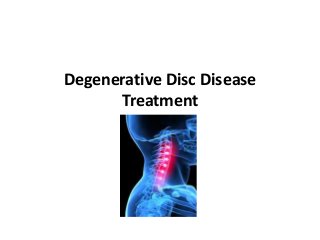
Degenerative Disc Disease Treatment
- 1. Degenerative Disc Disease Treatment
- 2. Individuals who have been diagnosed with degenerative disc disease have a number of treatment options at their disposal. Yet, before any treatment regimen can begin in earnest, it is extremely important to identify the cause, location, and severity of the problem. With this information in hand, the patient can work with their doctor, spine specialist, or other medical professional to develop a comprehensive treatment plan that will have the best chance of success.
- 3. Understanding Degenerative Disc Disease To find the best course of degenerative disc disease treatment, it is necessary to first understand what exactly the condition entails. The vertebral bones in the back and neck that make up the spinal column are cushioned and separated by thick, spongy intervertebral discs that act as shock absorbers for the spine. It is these discs that allow the vertebrae to articulate against one another comfortably, providing the regular movement that is expected from the back and neck. Each disc is made of two main components: a thick outer shell and soft inner core. The outer shell, known as the annulus fibrosus, contains the inner gel-like nuclear material, which is known as the nucleus pulposus. The condition known as degenerative disc disease causes the deterioration of the annulus fibrosus, which can allow the disc walls to extrude beyond their normal parameters, or rupture, paving the way for the nucleus pulposus to seep into the spinal column.
- 4. Causes Generally speaking, degenerative disc disease develops as a result of nothing more than the natural aging process and is particularly common in the cervical spine in the neck and the lumbar spine in the lower back. Over the years, the wear and tear associated with regular mobility in the spine takes its toll, causing the components that support the spinal column to gradually deteriorate. Some degree of deterioration is an unavoidable byproduct of the aging process, however, when the spinal degeneration advances to the point that symptoms arise, the patient is said to have degenerative disc disease.
- 5. Conservative Treatment One of the good things about degenerative disc disease is that in most cases it can be treated with a regimen of conservative, noninvasive techniques. More often than not, the symptoms stemming from this condition are caused by the damage, irritation, or constriction of a nerve root or the spinal cord near the affected disc. So, treatments are designed to alleviate this irritation. The secret to treatment is to find the right combination of techniques that will best serve the patient, as what works for one won’t necessarily work for all. It is also exceedingly important for the patient to maintain the proper expectations for degenerative disc disease treatment. There is no silver-bullet cure for degenerative disc disease. Instead, treatment usually takes several weeks or months until the patient finds sufficient and long-lasting pain relief. While treatment options vary from patient to patient, some combination of prescription or over-the-counter nonsteroidal anti-inflammatory drugs, epidural injections, physical therapy, light exercise, hot therapy, and/or cold therapy are most often recommended.
- 6. Surgical Intervention In some instances, when all other treatment plans fail to provide the expected relief, spinal surgery may be recommended as a final degenerative disc disease treatment option. In this case, there are several different approaches to surgery that may be recommended ranging from the highly invasive to the lightly invasive. Each type of surgical procedure has its own utility, limitations, and sacrifices, which is why it pays to do homework and research the various avenues available. Never consent to a surgical procedure without receiving a second and third opinion, and make sure that you are completely comfortable with the proposed operation, your diagnosis, and your doctors. To learn more about degenerative disc disease treatment, speak with a physician today.